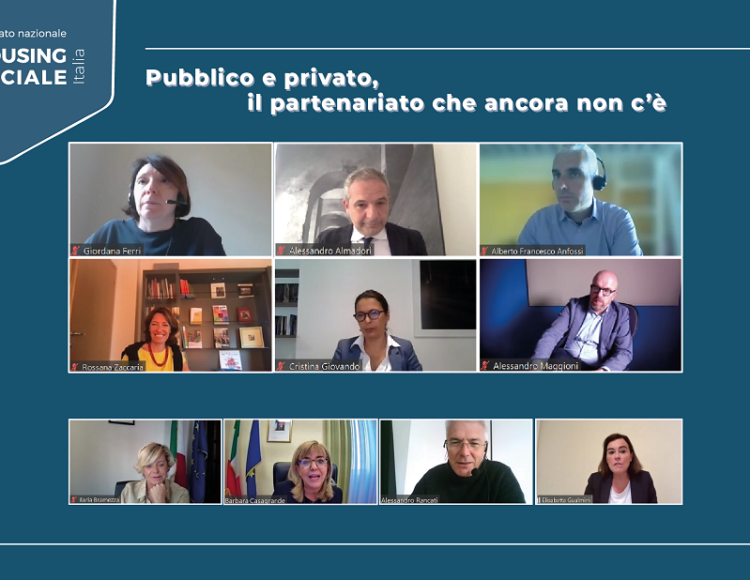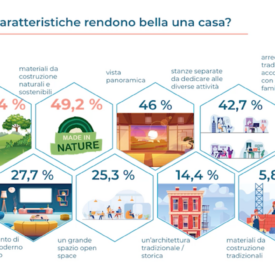In the framework of the New European Bauhaus Initiative, the Italian National Committee for Social Housing organised three encounters to foster a debate on the future of housing and its present-day challenges across the Italian territories, calling for more united and adaptive approaches. Eva Sporer from our Italian member, Legacoop Abitanti brings together the key messages from these series of events.
Taking housing as social infrastructure and its role within the National Recovery Plan as a starting point, the Committee started off the webinar series with a dialogue between national and European representatives on the theme of public-private partnerships. In most of Europe, this tool is considered a consolidated modus operandi of public administration, especially when it comes to urban regeneration and new social housing projects, that involve many phases of neighbourhood transformation. Coordination among sectors here is key to respond to the demand of existing and future residents.
In Italy, on the contrary, there is still a marked separation between the exclusively public intervention, the private and the public-private one, and consequently also a persistent partition between the types of offers. Nonetheless, in the last twenty years, the sector has laid the foundations for the construction of a social housing system capable of operating in response to wider needs and with a view to collaboration between the various actors. These experiences give us a glimpse into an emerging system that has made collaborative practices and their effectiveness visible. There is still a long way to go and resistance to overcome. Operational issues make partnership initiatives complex, due to the lack of administrative tools and regulatory instruments capable of facilitating clear public decision-making processes. The time however is ripe to start to structure public-private initiatives of collective interest, with housing as its main link.
The discussion touched upon how to adopt an integrated approach to planning from an urban to a social management and financial project. The importance of responding to the scale of the individual neighbourhood and providing a strong functional mix of non-residential services that also develop the city, was underlined. There is consensus among the cooperative, private and public sector that the opportunity of complimentary funds, both domestic ones and EU-funded, need to be guided by monitoring work on project progress and if needed followed up by correction measures. For public housing companies, such as the ones represented by Federcasa, the role of responsive governmental structures is essential to receive tangible results and to have the opportunity to co-finance various projects. Private actors on the other hand need to be involved not solely through investment but commitment. The introduction of a financial blending model is promising, still there persists confusion about how to use it adequately. Fondazione Housing Sociale outlines such a scheme, elaborated below on the basis of Housing Europe’s example, addressing the properly functioning delegation of resources.
During the round table, representatives of the Ministry for Infrastructure and Sustainable Mobilities announced the launch of a design fund for PPP to tackle some of the mentioned obstacles. This highlights that to deal with urban policies and infrastructure projects we have to work in a sectoral manner, from urban mobility concerns to urban requalification projects, that lay at the heart of innovation for the surrounding areas and city out-skirts. Facility management that follows a project in its entirety can guide other projects, fostering transparency and competition.
The European perspective was brought into the dialogue by representatives of the European Parliament and of the European Commission Joint Research Centre. The New European Bauhaus is all about translating new needs into tangible outcomes in space in a two-fold manner. Firstly, by prioritising the transformation of places and secondly by linking the recovery of a sense of place belonging to our own identity. Initiatives like the AHI District Demonstrator focus on places that can generate innovation in the social economy. As many activities can support social housing, it is helpful to create links between funding calls and actors across boards. Regarding the project of the PPP, the NEB can function as a concrete connector between practitioners working on match funding.
The second webinar focused on experiences and models of youth housing and inclusive territories. Young people undergo a series of transitions that the housing market is increasingly incapable to address. 39,9% of people aged 25-35 in Italy live in rentals, of which 37% are looking for an accommodation for one year and 39% for two years. The situation in urban centres is more precarious, as sharing rooms is a norm for many students and young workers due to rent prices and a lack of offers.
Flexibility and adaptation are essential for young people. Projects need to help in facilitating these transitions to foster independence without making big life decisions early on. This goes hand in hand with promoting inclusion in urban and labour contexts, as housing touches upon different life spheres and reflects social security.
The session laid out successful projects, among many cooperative experiences, from city-wide youth housing centres fostering mutual aid and knowledge exchange across Milan and Torino, new guidelines for social housing rents dedicated to people under 30, projects that try to tackle migrant youth segregation early on in life, to digitalizing the rental market for young people in Southern Italian cities, and the empowerment of students in becoming active stakeholders in the transformation of historic centres such as the university city of Bologna. The director of the National Agency for Young People concludes the dialogue with the thought that housing is an informal educational experience and that our living spaces need to be designed for growing. Young people should be allowed to contribute to a place but should not be pinned down, in order to allow cross-fertilisation. This also shows that there is a need to incentivize networking among young projects and inter-generational alliances for housing. We also see a growing desire among the ages 18-39 to return to hometown communities after having stayed abroad or in bigger cities for training and education. We therefore need to look “beyond Milan” and introduce models that focus on different regional realities.
The closing event touched upon community building and urban regeneration and shared the findings of the Committee’s questionnaire “Imagining the home of the future together”. The outcome supports people’s need to have outdoor spaces both within their own home and for the community. They want inter-generational residences and ask for more social managers, people want to share time within the community and need to have a guarantee of affordability. As a result of the pandemic, residents are more in favour of separate rooms for work and study, and they are more willing to switch homes throughout the life course. Most respondents believe in the importance of life in cities and the need to regenerate and connect places in-between the city and the countryside.
The debate reinforced concepts like the “15-minute city” and the opportunity of the NEB initiative in raising the ambition of designers and creative actors in making living spaces. Art as an educational tool for the public spaces of our neighborhoods is as integral as the daily work of “proximity welfare” by shared administration and eco-systemic services among private and public partners. The EU Climate Report for the Mediterranean Region paints an alarming picture: urban centers are at risk of not maintaining and increasing livability of future cities over the next two decades, meaning immediate action is needed. The environmental aspect is not only important to make our cities future-proof but to combine investment plans and create circular urban economies that include sharing services and co-housing. These correspond to an ever-growing awareness and felt urgency of residents and their adapted lifestyles. To counteract the perception of green washing these ambitions, the panelists shared the common successful experience of using mapping as a tool to show residents where resources and inequalities are located in order to aid the communication of an environment-health nexus in a playful way.
Comitato Nazionale per l’Housing Sociale
The Italian National Committee for Social Housing is a network committed to laying the foundations for a new housing and urban regeneration policy across Italy. The Committee came into being thanks to the collaboration among Federcasa, Legacoop Abitanti, Confcooperative Habitat, Fondazione Compagnia di San Paolo, Fondazione Housing Sociale, Fondazione Sviluppo e Crescita CRT.
Keep up to date with the work of the Committee via: https://www.cnhousingsociale.it/about/english
Find the recordings of the webinar trilogy and more here soon.

, Presentation, Madrid, 13 June 2014-275x275.png)
